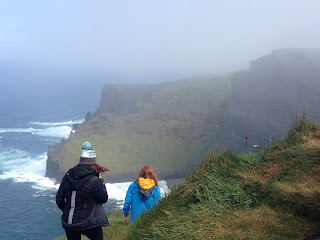Na Fianna Gaelic Athletic Club
Purity in our hearts. Strength in our limbs. Action
according to our words.
These words in Gaelic (Glaine in ár gcroí. Neart in ár nGeag.
Beart de réir ár mbriathar.) serve as the motto for the Gaelic Athletic Club Na
Fianna where the students spent their Saturday morning participating in
traditional Gaelic games and activities.
Based in Glasnevin on the northside of Dublin, Na Fianna was
founded in 1955 and is a major power in Dublin senior football circles, winning
three county titles in a row from 1999-2001 and earning the Leinster championship
in 1999.
At Na Fianna, the students started with a short presentation
and video explaining the Gaelic games of football and hurling. While the
students had learned about the games at Croke Park, the home of the Gaelic
Athletic Association, and at University of College Dublin, during the presentations
and Q&A with Gaelic footballer Eamon Wallace, the nervous tension in the
room was noticeable, as the students would now be putting their own skills to
the test.
The activities began simply enough with the students
practicing and playing small games of handball on an outdoor handball court. One-walled,
two-walled, and three-walled games filled the first session of the day followed
by a quick drink of water and a light snack. All of the students performed well
in handball and left the session buoyed by the ease with which they adapted to
the game and the simple rules and maneuvers.
After handball, the students were introduced to Gaelic
Football. The instructors noted three key elements of the game that Americans,
and others, often struggled with. Those were: 1) You CANNOT throw the ball, 2)
You CANNOT pick the ball up directly off the ground, and; 3) You should NEVER stop
and pivot on a plant foot like you do in basketball.
Needless to say, the Baldwin Wallace students regularly and
spectacularly made these mistakes. Some struggles with the rules aside, the
students greatly enjoyed the game and participated in a spirited match against
one another with former BW faculty member and Irish national Dr. Alvy Styles
leading her side to victory.
The post-game confidence wasn’t as high after Gaelic
Football as it was after handball, but the students were still relatively
confident in their athletic abilities as they had quickly mastered game
techniques, but had failed only at truly mastering the rules of play. An
acceptable mistake for any beginner trying to process the intricacies of a new
sport.
The next athletic adventure would not be so kind. Again,
after a quick drink of water and a light snack the students returned to the
playing field. This time, they would take on the game of hurling. And without
giving too much away, hurling won.
The basic skills of handball and Gaelic Football were fairly
seamlessly adopted and performed by the students; however, in hurling, this was
not the case. Gripping the hurling stick, which requires your dominant hand to
be the low hand (opposite of baseball and softball), was a challenge for many
of the players. This was complicated by the ideas of scooping the ball,
balancing the ball, and striking the ball with swings from either side.
To be honest, the skills were nowhere near close to mastered
before a game commenced. The hive mentality of the hurling game, reminded one
of small children playing soccer and the students’ game was mostly played like
a game of field hockey with occasional moments of skill demonstration by a few
of the players. And while skill may have been absent from the game, fun was
most definitely had.
The difficulty of the game left many students questioning
their athletic ability, as one BW student-athlete noted, “I’ve never felt more
unathletic than I do right now.” It was a sentiment shared by many.
With handball, Gaelic Football, and hurling out of the way,
one final challenge awaited the students: Irish Dancing. Retreating from the playing
fields to the banquet hall, the students learned a traditional Irish dance in a
step-by-step process that afforded them the opportunity to build skills and
confidence.
In the end, the Irish dancing performance by the students
was an athletic feat performed by their appropriately moving feet. It was their
best performance of the day, and while, far from perfect, it was the perfect
ending to a perfect day.
Sunday was a free day for the students and included a Hop
On, Hop Off bus pass that allowed students to take advantage of all the city of
Dublin has to offer and explore any avenues of the city they would like to see.
Stops along the Hop On, Hop Off bus tour included: Trinity College, The
National Library & Museum, The National Gallery, St. Stephen’s Green,
Temple Bar, Dublin Castle, Christchurch Cathedral, St. Patrick’s Cathedral,
Phoenix Park, Four Courts, and the ever-popular Jameson Distillery and Guinness
Brewery.
The next two days include a visit to the Cliffs of Moher and
Galway on Monday and the Boyne Valley on Tuesday, which includes Loughcrew, Mellifont
Abbey, The Hill of Slane, Trim Castle, and The Hill of Tara.
Baldwin Wallace University Sport Management: Experiential Learning from Day One!

































